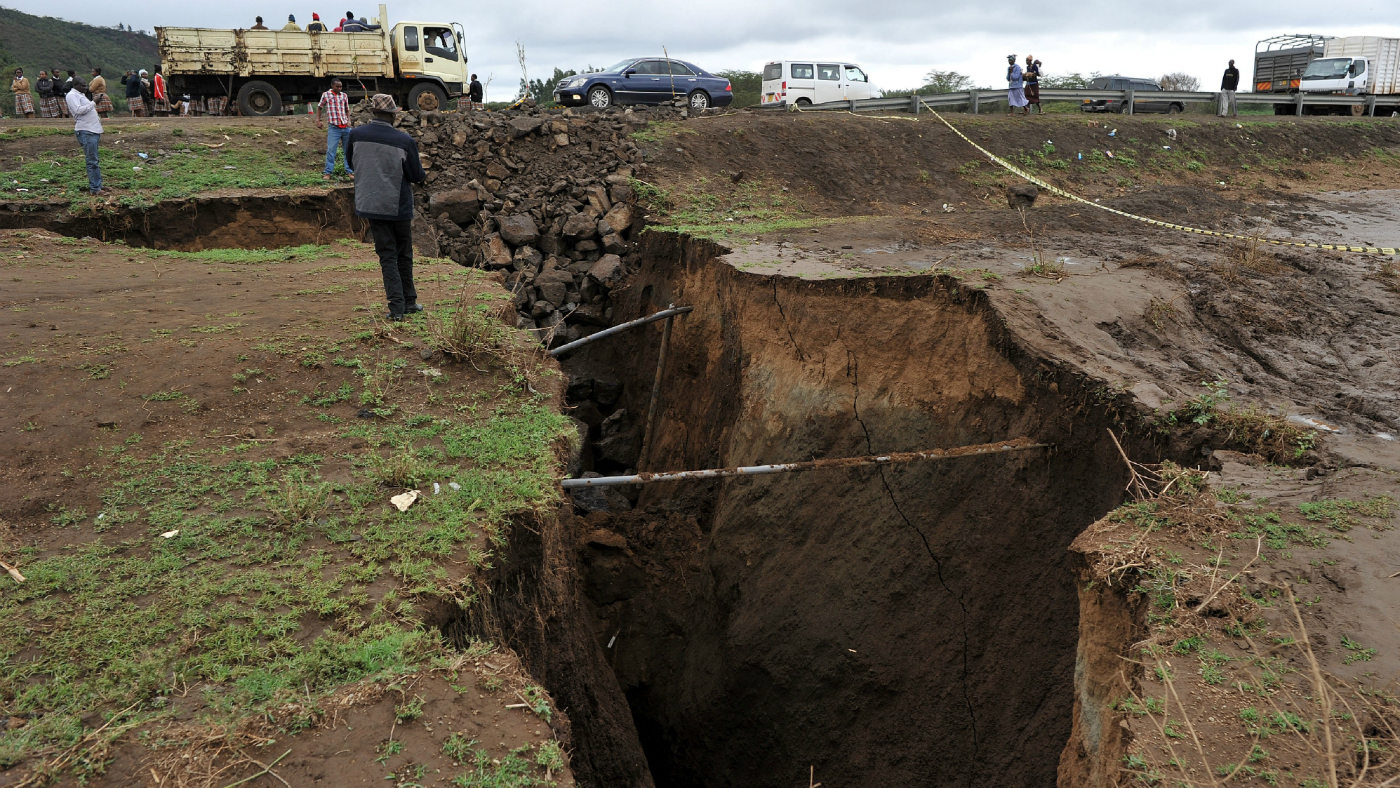Africa splitting in two: what's happening to the continent?
Huge chasm 65ft wide appears in Kenya’s Great Rift Valley after heavy rains

Heavy rains have opened up a giant chasm in Kenya, leading to predictions that the African continent will split into two.
The crack in the Great Rift Valley, which appeared mid-March, measures more than 50ft in depth, 65ft across and several miles in length, reports National Geographic.
The sudden appearance of the chasm, which caused part of the Nairobi-Narok highway to collapse, was exacerbated by seismic activity in the region, PBS reports.
The Week
Escape your echo chamber. Get the facts behind the news, plus analysis from multiple perspectives.

Sign up for The Week's Free Newsletters
From our morning news briefing to a weekly Good News Newsletter, get the best of The Week delivered directly to your inbox.
From our morning news briefing to a weekly Good News Newsletter, get the best of The Week delivered directly to your inbox.
A witness said the opening appeared so quickly he was able to watch it form and run through his home, reports Reuters. He only just managed to collect some of his belongings before his house collapsed.
The crack appeared along the 3,700 mile-long East African Rift, where the Somali tectonic plate in the east and the Nubian plate in the west move away from each other, adds National Geographic.
“Eventually, the Somali plate may completely separate from the Nubian plate and form a separate land mass comparable to Madagascar or New Zealand. Fortunately for those who live there, that separation isn't expected to happen for another 50 million years,” it continues. “It does mean, however, that the physical effects of that separation will continue to be felt.”
According to a paper published in Nature, the East African Rift System “remains one of the least monitored tectonic plate boundaries, which makes it challenging to constrain present-day seismic hazards”, meaning further damage to infrastructure in the region may take place unless authorities “plan [the region’s] infrastructure accordingly, saving lives and livelihoods in the process”, Slate adds.
A free daily email with the biggest news stories of the day – and the best features from TheWeek.com
It is expected that an enormous section of East Africa will break away from the main continent, but not for tens of millions of years.
-
 Critics’ choice: The year’s top 10 movies
Critics’ choice: The year’s top 10 moviesFeature ‘One Battle After Another’ and ‘It Was Just an Accident’ stand out
-
 The small Caribbean island courting crypto billions
The small Caribbean island courting crypto billionsUnder the Radar Crypto mogul Olivier Janssens plans to create a libertarian utopia on Nevis
-
 Political cartoons for December 21
Political cartoons for December 21Cartoons Sunday’s political cartoons include Christmas movies, AI sermons, and more
-
 How Bulgaria’s government fell amid mass protests
How Bulgaria’s government fell amid mass protestsThe Explainer The country’s prime minister resigned as part of the fallout
-
 Femicide: Italy’s newest crime
Femicide: Italy’s newest crimeThe Explainer Landmark law to criminalise murder of a woman as an ‘act of hatred’ or ‘subjugation’ but critics say Italy is still deeply patriarchal
-
 Brazil’s Bolsonaro behind bars after appeals run out
Brazil’s Bolsonaro behind bars after appeals run outSpeed Read He will serve 27 years in prison
-
 Americans traveling abroad face renewed criticism in the Trump era
Americans traveling abroad face renewed criticism in the Trump eraThe Explainer Some of Trump’s behavior has Americans being questioned
-
 Nigeria confused by Trump invasion threat
Nigeria confused by Trump invasion threatSpeed Read Trump has claimed the country is persecuting Christians
-
 Sanae Takaichi: Japan’s Iron Lady set to be the country’s first woman prime minister
Sanae Takaichi: Japan’s Iron Lady set to be the country’s first woman prime ministerIn the Spotlight Takaichi is a member of Japan’s conservative, nationalist Liberal Democratic Party
-
 Russia is ‘helping China’ prepare for an invasion of Taiwan
Russia is ‘helping China’ prepare for an invasion of TaiwanIn the Spotlight Russia is reportedly allowing China access to military training
-
 Interpol arrests hundreds in Africa-wide sextortion crackdown
Interpol arrests hundreds in Africa-wide sextortion crackdownIN THE SPOTLIGHT A series of stings disrupts major cybercrime operations as law enforcement estimates millions in losses from schemes designed to prey on lonely users